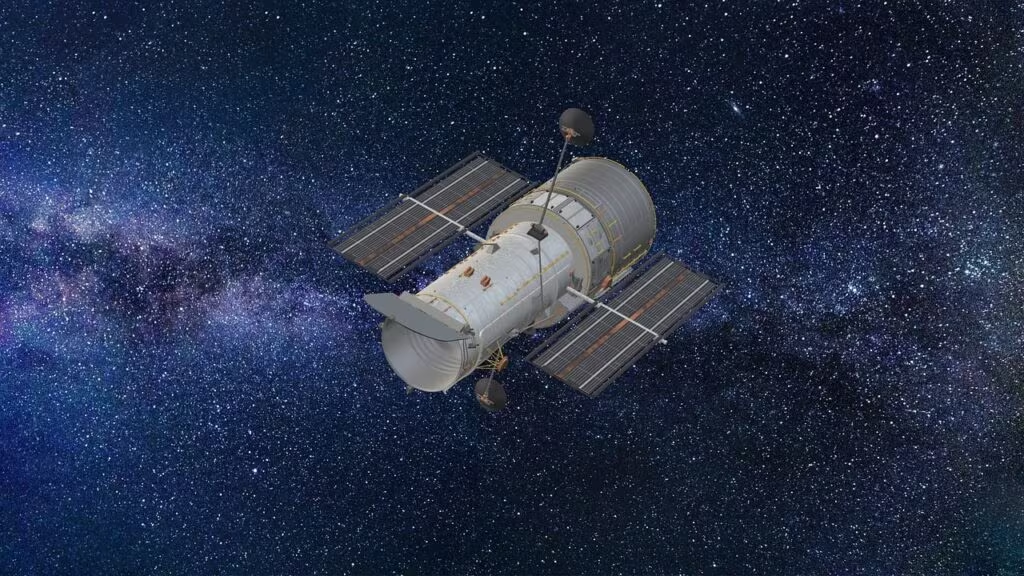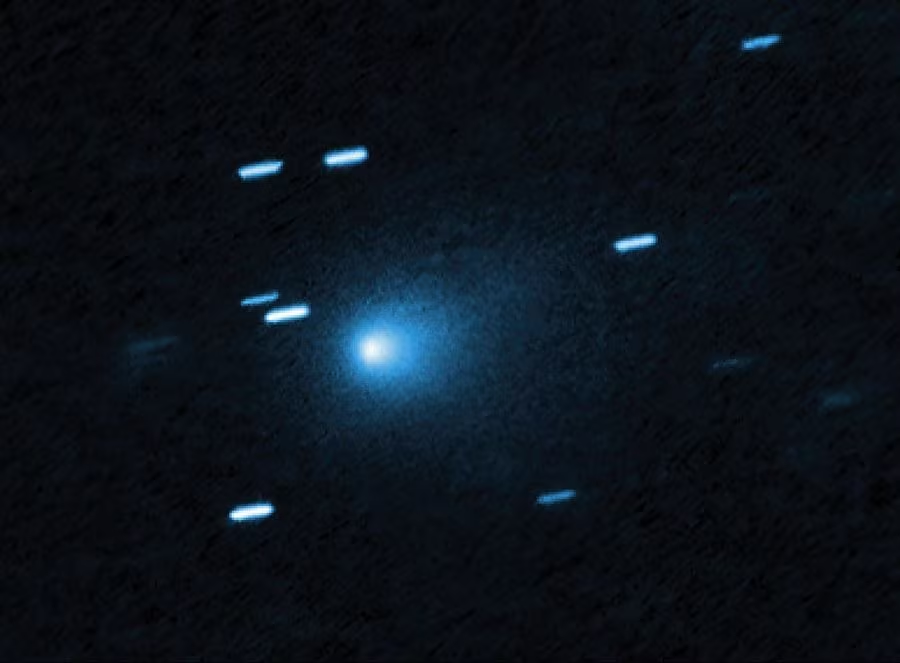Unpacking the Mystery of Interstellar Comet 3I/ATLAS
In the ever-expanding field of astrophysics, few subjects ignite public imagination quite like interstellar objects—visitors from beyond our solar system. When the Hubble Space Telescope captured images of Comet 3I/ATLAS on July 21, 2025, the data confirmed its unusual nature. Located approximately 277 million miles from Earth at the time of observation, the comet displayed a distinct, teardrop-shaped cocoon of dust (known as a coma).
While astronomers initially focused on the comet’s trajectory and composition, the discussion quickly moved into the realm of the extraordinary when a prominent Harvard astrophysicist proposed a radical hypothesis: that 3I/ATLAS might not be a natural phenomenon, but rather a piece of advanced technology—an “alien ship.”
This article delves into the scientific facts surrounding Comet 3I/ATLAS, the controversial theory put forth by the Harvard expert, and the broader implications for the search for extraterrestrial intelligence (SETI).
The Scientific Profile of Comet 3I/ATLAS
Comet 3I/ATLAS is classified as an interstellar object, meaning it originated outside the gravitational influence of our Sun, likely ejected from a distant star system. Its designation, 3I, marks it as the third confirmed interstellar visitor detected passing through our solar neighborhood, following the famous 1I/’Oumuamua and 2I/Borisov.

Observations from the Hubble Space Telescope in mid-2025 provided critical details about the object’s appearance. The most notable feature was the teardrop-shaped coma, a cloud of dust and gas surrounding the nucleus. In traditional comets, this coma is formed as volatile materials (ices) sublimate when the object approaches the Sun. However, the specific shape and behavior of the coma in 3I/ATLAS, combined with its interstellar origin, fueled the ensuing debate.
Interstellar objects are invaluable to science because they offer a direct sample of material from other star systems, providing clues about planetary formation processes elsewhere in the galaxy. Their rarity and speed make detailed observation challenging, which often leads to incomplete data and, consequently, room for speculation.
The Controversial Hypothesis: A Non-Natural Origin
The suggestion that Comet 3I/ATLAS could be an artificial structure comes from Dr. Avi Loeb, the former chair of Harvard University’s Department of Astronomy. Dr. Loeb is well-known for his work on ‘Oumuamua, which he famously suggested could have been a piece of alien technology, or a ‘light sail,’ due to its non-gravitational acceleration.
While the specific details regarding 3I/ATLAS differ from ‘Oumuamua (which was initially classified as an asteroid and showed no visible coma), Dr. Loeb’s hypothesis regarding 3I/ATLAS follows a similar line of reasoning:
Why the Artificiality Claim Arose
Dr. Loeb and his team often argue that when an interstellar object displays characteristics that defy easy explanation using known cometary or asteroidal physics, the possibility of an artificial origin should be considered as a legitimate scientific hypothesis, not just science fiction. For 3I/ATLAS, the arguments likely center on:
- Unusual Coma Dynamics: If the teardrop shape or the rate of outgassing (if any) did not perfectly align with standard models of cometary sublimation, it suggests an unknown force or structure is at play.
- Interstellar Rarity: The sheer improbability of detecting three such objects (1I, 2I, and 3I) in rapid succession suggests that either our solar system is a cosmic magnet for debris, or that a large population of these objects exists, potentially including engineered ones.
- Precedent of ‘Oumuamua: Having established a framework for considering artificiality with the first interstellar object, subsequent unusual objects like 3I/ATLAS are now scrutinized through the same lens.
“When we encounter an object that deviates significantly from the expected behavior of a natural comet or asteroid, we must maintain intellectual humility and explore all possibilities, including the technological,” Dr. Loeb has stated regarding interstellar visitors.
It is crucial to note that this hypothesis remains highly speculative and is not the mainstream view within the astronomical community.
Contextualizing the Scientific Debate
The scientific community approaches claims of extraterrestrial technology with extreme caution, adhering to the principle that extraordinary claims require extraordinary evidence. The standard scientific methodology dictates that all natural explanations must be exhausted before considering an artificial origin.
Natural Explanations for Unusual Behavior
For 3I/ATLAS, the most likely explanations for its unusual appearance, including the teardrop-shaped coma observed by Hubble, involve complex, yet natural, phenomena:
- Compositional Differences: The comet may contain unique volatile ices (like nitrogen or carbon monoxide) that sublimate differently than water ice, leading to an unusual dust ejection pattern.
- Fragmentation or Rotation: The object might be rotating rapidly or undergoing minor fragmentation, which could cause the dust to be ejected unevenly, creating the observed asymmetric, teardrop shape.
- Dust Grain Size: The size and density of the dust grains being shed could influence how sunlight pushes them away, affecting the visible shape of the coma.

While Dr. Loeb’s work ensures that the possibility of artificiality is discussed, the vast majority of astronomers currently favor natural explanations for the behavior of 3I/ATLAS, pending further data. The challenge lies in the fact that these objects are only observable for a short window as they pass through the inner solar system, making definitive conclusions difficult.
Key Takeaways: What the Reader Needs to Know
The arrival and observation of Comet 3I/ATLAS mark another significant milestone in our understanding of the cosmos. Here are the essential facts and points of contention:
- The Object: Comet 3I/ATLAS is the third confirmed interstellar object detected in our solar system.
- The Observation: On July 21, 2025, the Hubble Space Telescope observed 3I/ATLAS at 277 million miles from Earth, noting its distinctive teardrop-shaped dust cocoon.
- The Claim: A prominent Harvard professor, Dr. Avi Loeb, suggested the unusual characteristics of the object could potentially indicate an artificial, technological origin (an “alien ship”).
- The Consensus: Mainstream astronomy views the artificiality hypothesis with skepticism, prioritizing natural explanations such as unique volatile compositions or complex rotational dynamics.
- The Significance: Interstellar objects like 3I/ATLAS provide unique, fleeting opportunities to study material from distant star systems, regardless of their ultimate classification.
Conclusion: Looking Ahead in the Search for Interstellar Visitors
The controversy surrounding Comet 3I/ATLAS underscores the evolving nature of astronomy in the 21st century. As detection capabilities improve, particularly with projects like the Vera C. Rubin Observatory coming online, the discovery rate of interstellar objects is expected to increase dramatically. This will provide more data points, allowing scientists to build better statistical models to distinguish between natural cosmic debris and potentially engineered artifacts.
For now, 3I/ATLAS remains a fascinating enigma—a fast-moving visitor from another star, prompting us to ask profound questions about our place in the universe and the possibility of life beyond Earth. While the “alien ship” theory captures headlines, the true value of 3I/ATLAS lies in the hard data it provides about the materials and processes occurring in distant stellar neighborhoods.
Original author: Alexis Simmerman
Originally published: October 29, 2025
Editorial note: Our team reviewed and enhanced this coverage with AI-assisted tools and human editing to add helpful context while preserving verified facts and quotations from the original source.
We encourage you to consult the publisher above for the complete report and to reach out if you spot inaccuracies or compliance concerns.

